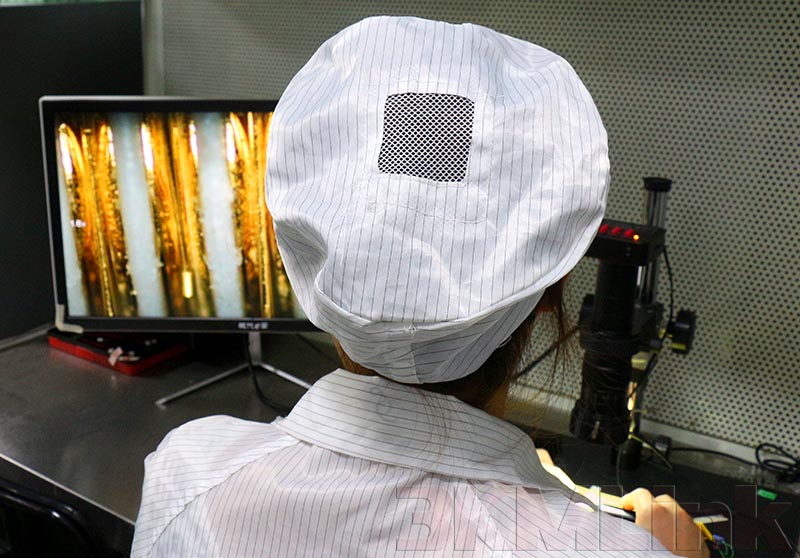Comparative analysis of slip ring contacts' coating process performance
Comparative analysis of slip ring contacts' coating process performance
--The 1st wear-resistant and corrosion-resistant superhard precious metal processing technology in the slip ring industry(ENAP)
The contact structure design and processing technology of the electric slip ring is the most core technical process, which directly affects the working life,conductivity, stability and reliability. Wear resistance and corrosion resistance are key indicators related to the stability and reliability of slip ring contacts. For example, the conductivity of silver plating is recognized as the highest, but due to the low oxidation resistance and wear resistance of silver, the Chinese aerospace industry standard QJ450A clearly stipulates that the friction parts are not allowed to be silver plated.

In the slip ring industry, the surface treatment technology of contacts is mostly nickel-based, and then silver, gold, precious metals or their alloys are used as the surface layer, such as: silver plated (Ep•Ag), nickel plated silver (Ep•NiAg) ), gold-plated (Ep•Au), nickel-plated gold (Ep•NiAu), nickel-plated hard gold (Ep•NiAuhd), etc. Some high-quality requirements adopt high-cost electroless nickel-palladium immersion gold technology (ENEPIG).
Among these surface treatment technologies, the electroless nickel-palladium immersion gold technology (ENEPIG) is considered to be the current PCB and connector contact due to its low contact resistance, good electrical conductivity, easy soldering, and strong corrosion resistance, it is the most ideal surface treatment technology in the electronic and electrical fields. However, it has a fatal weakness when applied to contacts in the slip ring industry, because the outermost pure gold (or hard gold) immersion coating technology process is extremely difficult to balance wear resistance, corrosion resistance and ductility. it's difficult to meet the friction requirements of slip ring contacts for a long time, high speed, high temperature, and high conductivity. Therefore, it is only suitable for relatively static, non-friction contacts.
The process is complex, the cost is high, and the cost-effective advantage is not obvious. This is why the electroless nickel-palladium immersion gold technology has become so popular in the connector field for more than ten years, but it has not been able to replace the nickel-plated hard gold technology (Ep•NiAuhd) in the slip ring market. Important reason for the dominant position.

With the rapid development of science and technology in high-end fields such as military, aerospace, and navigation, the existing slip ring contact surface treatment technology has become increasingly difficult to adapt to the market application requirements of high speed, long life, and high stability. Some slip ring manufacturers have adopted solutions such as adding lubricating grease, increasing the thickness of the coating, secondary surface polishing, reducing the pressure of the brush wire or even reducing the speed requirements. These methods need to sacrifice certain quality performance and cannot solve the problem fundamentally. Cause some safety hazards to the electric slip ring, such as "Analysis on the hidden dangers of using lubricating grease in electric slip rings".
In order to break through the technical bottleneck of contacts in the slip ring industry, we have conducted a large number of research experiments and analyses on various rare and precious metals such as rhodium, palladium, gold, silver, cobalt, iridium and their alloys, as well as related electroplating technology and process performance. Successfully developed a wear-resistant and corrosion-resistant super hard precious metal surface treatment technology for slip rings, which is plated with a three-level metal element alloy film (ENAP, Electroless Ni Au Pd) of nickel, gold, and palladium, which has extremely high chemical stability It is resistant to high and low temperature, high humidity, acid and alkali corrosion, high hardness, can withstand bending, extension and friction, and its resistivity is equivalent to that of pure gold. After treatment, the strength, hardness and conductivity of the conductive slip ring contacts are better than the International Military Standards (MIL) for connector contacts. It is the most stable and reliable gold-plated surface treatment technology in the slip ring industry.

First of all, the surface hardness and wear resistance of the slip ring brush wire and the copper ring after ENAP treatment are extremely strong.
The surface hardness is as high as HV300-350, which is larger than common hard gold, equivalent to 17-4PH stainless steel. It is commonly used in the manufacture of offshore platforms, helicopter decks, aerospace (turbine blades), shafts, steam turbine parts, etc.
The surface roughness has reached Ra 0.2-0.4μm, the contact surface is very smooth, no lubricating grease is needed, and the potential safety hazards of lubricating grease are avoided; the signal flashing of the brush wire is avoided, and the fluctuation resistance value is also significantly reduced, as low as 0.001Ω; The phenomenon of powder accumulation is greatly reduced, and the service life of the electric slip ring is prolonged. For example, the slip ring 3KM-C205F1-1502 is tested in a small batch of 10 million revolutions, the coating wear of the contact piece is ≤0.1μm, and the fluctuation resistance value changes to 0 before and after.
Secondly, ENAP has very stable chemical properties and excellent corrosion resistance.
Palladium is one of the rarest precious metals in the world. The content of the earth's crust is about one part per 100 million. It is produced only in a few countries such as Russia and South Africa, and the total annual output is less than 5‰ of gold. The palladium-gold alloy is made by adding a certain proportion of other metal elements to palladium. The melting point of the finished product is higher than 1500℃, which reduces the original brittleness of palladium-gold. It has extremely strong ductility and conductivity, and can withstand many times. Thermal shock, and to ensure that no cracks will occur during use; insoluble in nitric acid, sulfuric acid and strong alkali solutions, avoiding the disadvantages of easy corrosion of the gold surface by chloric acid, and ensuring the sliding contact elements in high temperature, salt spray, and humidity , Reliability and stability of applications in acid and alkali environments.
As we know in the process of electroplating, there will be contact and occasional corrosion between copper and gold, nickel and palladium, and ENAP super hard precious metal surface treatment technology very cleverly uses precious metal and nickel as barrier layers, which not only prevents gold The interdiffusion and penetration corrosion between copper, nickel and palladium-gold avoids the occurrence of grain boundary corrosion between the plating layers like the technical process of electroless nickel plating and immersion gold, and also improves the bonding force and the hard gold plating layer. The porosity is reduced, and the reliability of the entire coating is greatly improved.
"Tough as steel, smooth as a mirror; external corrosion resistance, internal corrosion resistance" This is the unique feature of ENAP's Super hard precious metal surface treatment technology. Although it has good overall performance, it is still used in conductive slip rings in high-demand fields such as military products, aerospace, and navigation due to the extremely high process cost.

Many slip ring manufacturers claim that the signal loop and brush wire of the slip ring use the "gold on gold" processing technology. Many customers may not expect the actual performance of the same "gold on gold", but they are very different. Below, the main performance characteristics of several commonly used electroplating techniques in the application of conductive slip ring contacts are compared as follows:

Note: Due to the material composition ratio, thickness, and refinement of the coating layer, the performance will be greatly different. For more direct comparison and better understanding, the performance indicators are roughly divided into "extremely low and low, Low-medium, medium, medium-high, high, and extremely high” 7 contrast levels.






